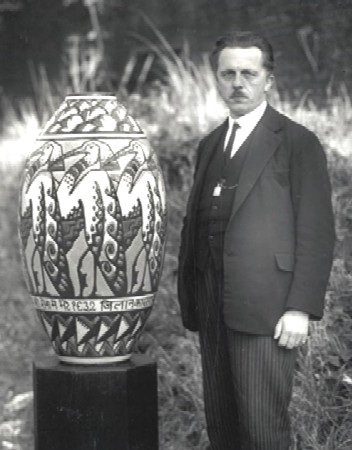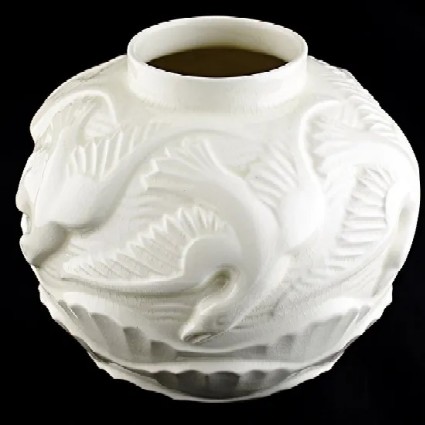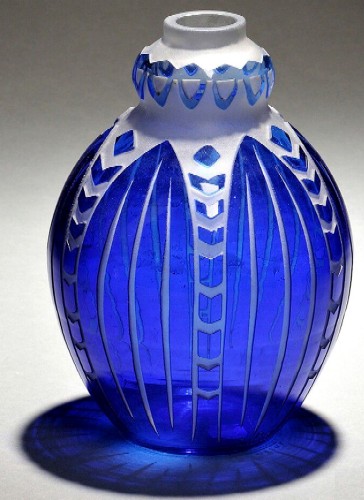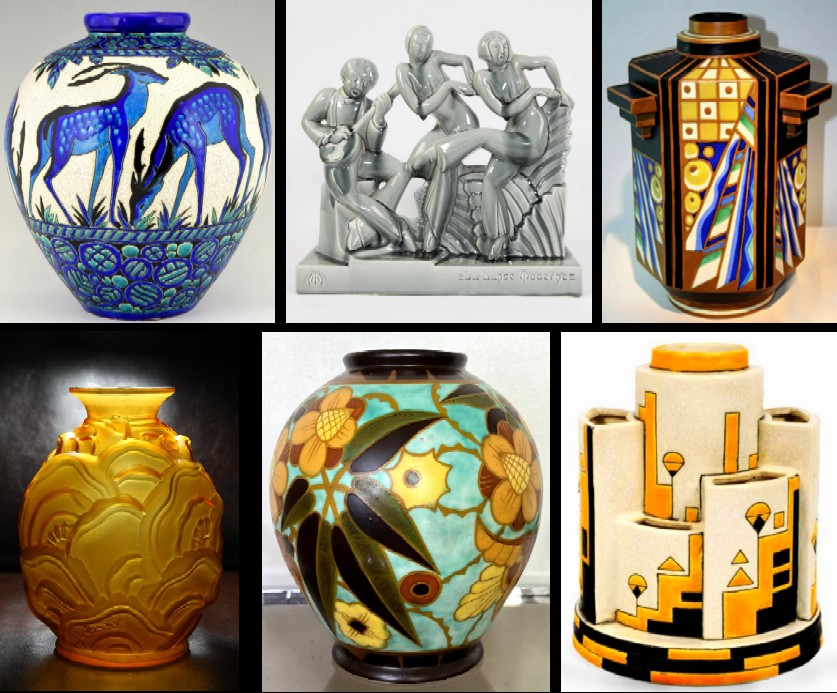
Charles Catteau (1880 - 1966)
"Charles Catteau could be regarded as one of the most versatile ceramic artists of his generation,

Charles Catteau with One of His Vases, Archives Keramis
especially for the style of Art Deco. Catteau advanced the forms, techniques and decoration of modern ceramics, creating an exceptionally original, new and decorative genre." ("Charles Catteau - Art Deco ceramics master", Venice Clay Artists website, gathered 9-23-24)
Charles Catteau was born in Douai, France. He attended school at the local academy between 1895 and 1897. As a boy, he showed a natural talent for drawing and painting, artistic skills which were honed at the Ecole Nationale de Céramique (National Ceramics School) as well as when he took a training course at the National Porcelain Factory in Sèvres. He completed his studies, graduating as a ceramic engineer in 1903 from the National Ceramics School.
Catteau was hired by Königliche Porzellan-Manufaktur (Nymphenburg Porcelain Factory) in Nymphenburg, Germany, near Munich in 1904. It was here that he was exposed to the German Jugendstil as well as French Art Nouveau styles. Jugendstil was essentially the German version of Art Nouveau, created as a reaction to the neo-classical style taught at the official German art and architecture academies. Munich was one of the centers of the movement, so it is not surprising that Catteau's encountered it while there. In addition to working for Nymphenburg Porcelain, Catteau also did some designs for the Societe Anonyme des Produits Ceramiques de Rambervillers in the Vosges. In 1905, the company introduced a Catteau jardiniere or planter decorated with swans.
In December of 1906, the Belgian earthenware company Boch Frères Keramis (Boch Brothers Ceramics) La Louvière, Belgium recruited Catteau with a desire to bring new ideas to their company. Artist Anna Boch had known Catteau in Munich and may have been instrumental in his hiring, although there is no proof for that. In 1907, he was promoted from designer and painter of sets of ceramics to the head of the decoration department at Boch Frères, a position which he retained for the rest of his career there.
in addition to his work with Boch Frères, Catteau took up teaching like other leaders in the artistic movement did during this period. Catteau was selected by the administrative committee of the industrial school of La Louviere to teach a decorative painting course in November of 1907. He continued to teach when the school merged with the Provincial Institute of Arts and Crafts in 1928, remaining there until retiring in 1946. In this way, he

Charles Catteau, Earthenware Vase with Relief Seagulls, Boch Frere,
1932, The Art Deco Boutique
trained dozens of the leading ceramic artists, glassblowers and decorators. He also encouraged learning at Boch Frères through exhibitions, conferences and the creation of a library. With Anna Boch, he helped found the Hainaut circle Les Amis de l'art in 1908, a group encouraging young artists. Catteau's ceramic decorations for Boch Frères before the war were traditional and romanticist designs, likely the style requested by company administration. He received a gold medal for a piece at the Universal Exhibition in Brussels in 1910 for a traditional style decoration.
Because Catteau retained his French citizenship, he was recruited into the French Army in 1914. He may have worked as a chemist at the Ecuelles Ceramics Factory, although this has never been conclusively proven. He was discharged in 1918. After the war a new company administration was more accepting of progressive decoration. Drawing on his experience with Art Nouveau in Germany, Catteau began incorporating Nouveau styling in some of his designs. As Art Deco overtook Art Nouveau, Catteau's designs for Boch Frères slowly transitioned from Nouveau to early Deco, eventually embracing the more rigid geometric designs found in Cubism. By the end of the 1920s, he also created some Art Deco style sculptures for the company although he was not a sculptor.
Some of Catteau's vases were included in the Salon d'Automne and at an exhibition at the Palais d'Egmont in Brussels in 1922. His work was praised in French design magazines like Art et Decoration and Mobilier et Decoration d'Interior. This resulted in orders from French department stores, with one requesting original designs. At the 1925 Exposition internationale des arts decoratifs et industriels modernes. Catteau was awarded a gold medal for his ceramic decoration. The industrial school of La Louviere where he taught also earned a silver medal at the Exposition, another nod to his design skills.

Charles Catteau, , Glass Vase with Acid Etched Design,
Scailmont, Belgium, Bonham's Skinner Auctions
Based on his success at the Exposition, Catteau signed a five year contract with the glass factory Verreries de Scaimont in Manage, Belgium. Because he was still working at Boch Frères, this work for the glass company was probably performed at home, with his glass designs being manufactured at Val-St-Lambert and Scailmont. "The success of Charles Catteau following the Paris Exposition of 1925 led to increasing popularity of their products and S.A. Verrerie de Scailmont employed 800 people at it's peak in 1930." ("Verreries de Scailmont, Manage", Hogelandshoeve & McLellan-Verhoeven, gathered 9-23-24)
During the 1930s, the demand for ceramics moved towards naturalism, causing a shift away from Art Deco designs towards classicism. Although he remained with the company until 1946, Catteau's involvement began diminishing in 1935. He lived in La Louviere for four years after his retirement, after which he moved to Nice. There he took up painting in a traditional style, dying at his home in Nice in 1966.
Boch Frères experienced "particular success in the first half of the 20th century with the arrival of Catteau, whose developments of form, technique and decoration transformed ceramics into an exceptional class of Art Deco wares." (Sophie Sevenoaks, "Collecting guide: Charles Catteau's Boch Frères ceramics", Christie's website, gathered 9-23-24 - https://www.christies.com/en/stories/charles-catteau-boch-freres-ceramics-689bfcee25984835ab8862abb971d394) Catteau's department produced "innovative and daring designs pushed the boundaries of traditional ceramic art and elevated the medium to new heights." ("Breaking Boundaries: Charles Chatteau's Art Deco Masterpieces at Boch Frères Keramis, Amitabha Studio", gathered 9-23-24) They produced 2300 numbered designs and 550 different shapes of ceramic products. He created "an incredible wide variety of designs. He experimented with shapes, material, glazes and textures." ("Charles Catteau", Wikipedia.com, gathered 9-23-24) Many of these designs mass-produced and sold for years.
Sources Not Cited Above:
"Charles Catteau", Gallerase website, gathered 9-23-24
"Charles Catteau the artist", Catteau Collection website, gathered 9-23-24
"Jugendstil", Wikipedia.com, gathered 9-23-24
"Styles and themes", Catteau Collection website, gathered 9-23-24
Claire De Pauw & Marcel Stal, Catteau, 2001, pp. 19-37
Original Facebook Group Profile
 Catteau Artwork, from left - Ceramic Vase with Deer, 1925 Exhibition, Boch Freres, Deconamic; La Danse Moderne in Celestial Grey, Boch Freres, c. 1930, Maison Jules; Earthenware Hexagonal Vase, Boch Freres, c 1925, Venice Clay Artists; Sculpted Amber Glass Vase, Scailmont, Bidsquare; Earthenware Vase, Boch Frere, 1920-30, Proantic; Earthenware Vase, Cubist Decoration, 1929, Venice Clay Artists
Catteau Artwork, from left - Ceramic Vase with Deer, 1925 Exhibition, Boch Freres, Deconamic; La Danse Moderne in Celestial Grey, Boch Freres, c. 1930, Maison Jules; Earthenware Hexagonal Vase, Boch Freres, c 1925, Venice Clay Artists; Sculpted Amber Glass Vase, Scailmont, Bidsquare; Earthenware Vase, Boch Frere, 1920-30, Proantic; Earthenware Vase, Cubist Decoration, 1929, Venice Clay Artists